Comic Book Review: The Sandman by Neil Gaiman
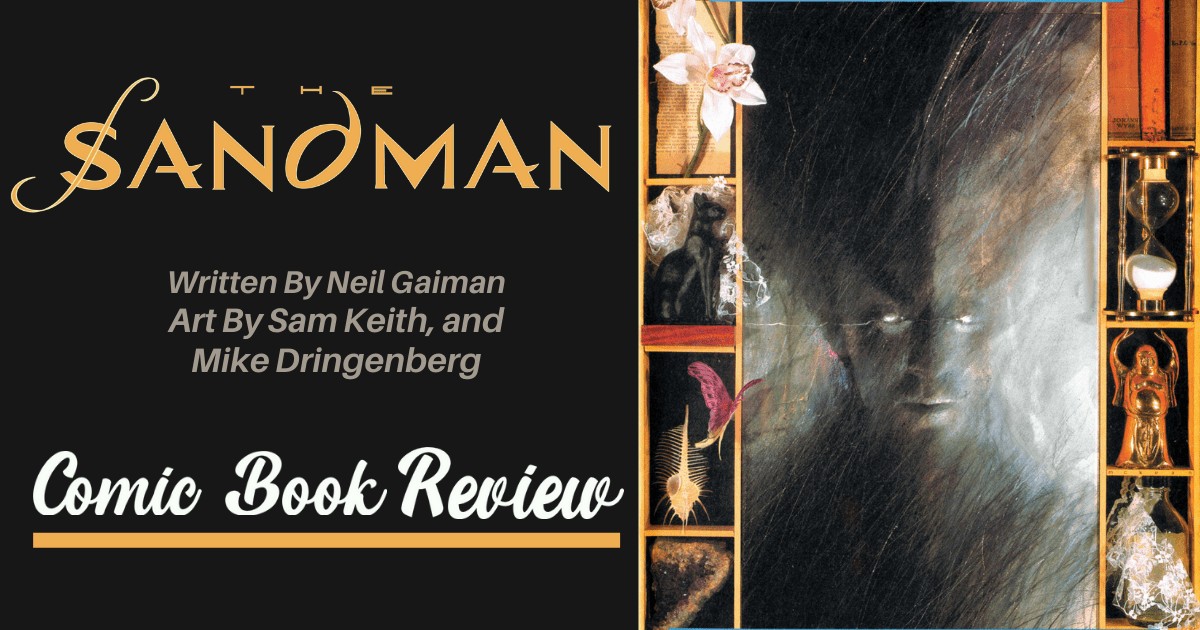
Netflix’s adaptation of Neil Gaiman’s limited run The Sandman series coming this August got me thinking that it would be nice to read the source and see what the fuss is all about. Gaiman wove a very different kind of tale with The Sandman. His highly compelling tale of imprisonment, freedom, and revenge lacks the traditional save the world storyline of most comics, although we do get there in the end.
Gaiman’s non-traditional tale, paired with beautiful artwork from Sam Keith and Mike Dringen made for a haunting story that lasted in my head long after I finished reading.
[Warning: My review of Neil Gaiman’s The Sandman contains some spoilers!]
The Sandman #1
In Issue #1 we meet the main character Dream, AKA Prince Morpheus. Morpheus isn’t a hero, a villain, or even an anti-hero. He is a powerful entity in charge of Dreamtime. As such, Morpheus has many responsibilities. But he has been imprisoned by a mystical order and his absence is having many negative effects on Earth. The comic begins jumping decades, checking in on different people around the world who are hurt by the imbalance in the universe caused by Dream’s imprisonment.
Eventually, so much time passes that those watching Morpheus begin to become complacent. He is able to escape but he is very weak. He needs his pouch, his helm, and his ruby to help him regain his strength. His captors took them from him when they first imprisoned him but over the decades they’ve lost these powerful objects. Needing their power to recover, Morpheus begins searching for them…
The importance of Dream
I loved the imbalances in the universe caused by Morpheus’s absence in The Sandman #1. It spoke to how important dreams are to people. Without dreams we are hopeless, drifting through life without fully engaging in it. Similarly, people either fell into periods of sleep from which they couldn’t be awakened or became perpetual sleepwalkers, unable to interact with anyone around them.
There were a few people who actually stopped sleeping. I believe these people reflect the other important function of dreams, a chance to unwind, relax, and disengage from the stresses of daily life. Without this release life becomes unbearable, and indeed those suffering from insomnia in the story end up committing suicide rather quickly if they do not find another release.
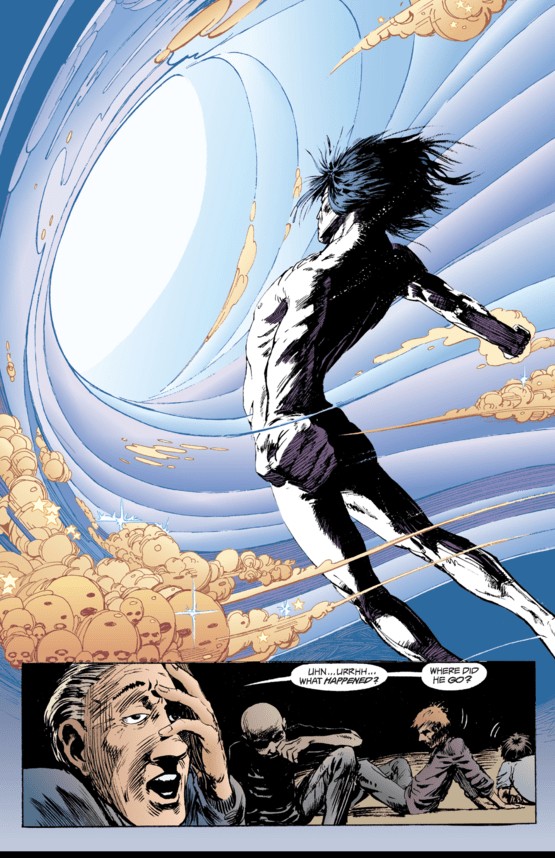
I really liked Gaiman’s take on the importance of dreams. As the caretaker of Dreamtime Morpheus is immensely important to the universe and the people in it. I really wanted to find out more about his realm in later issues and how he might interact with people through dreams. I couldn’t wait to find out why his tools, a pouch, a helm, and a ruby were so important and how he would manage to find them.
The Sandman #2
Neil Gaiman uses The Sandman #2 to lay out the rest of Morpheus’s quest. Morpheus is too weak to take back control of Dreamtime without his pouch, his helm, and his ruby. But he has no idea where they are. However, he knows who can help him.
Borrowed from many myths through time, Gaiman brings in the three-in-one, otherwise known as the fates. The maiden, the mother, and the crone allow him to ask one question, and only one, of each of them. The Maiden tells him that the last person to purchase his pouch was good ol’ John Constantine. The Mother tells him that his helm was traded to a demon long ago. Finally, the Crone informs him that the League of Justice has his ruby.
We also meet an important character in issue #2, Dr. John Dee AKA Dr. Destiny. Dr. Destiny is in Arkham Asylum where he has been for a long time. He hasn’t dreamed in ages and Morpheus’s return has not helped him. Dee is a very creepy character with some major mommy issues to boot. He seems unimportant now but there is the fact that Morpheus’s return has not affected his dream problem that makes him seem like someone to keep tabs on.
The roadmap
Issue #2 was a fast read, but extremely important. Besides introducing a possible future baddy the main aim of Issue #2 was to lay out the path that Morpheus is going to walk as he regains his powers.
I have to admit, knowing that a visit to John Constantine, a trip to hell, and an encounter with the League of Justice were ahead made me want to hurry up and read the remaining issues, which is the whole point right? I do wonder who we’ll meet in Hell, after all, Constantine and League of Justice are obvious references to other DC properties but Hell is kinda generic. I’m sure someone will be there (Lucifer perhaps) and my interest is piqued, just like Gaiman intended.
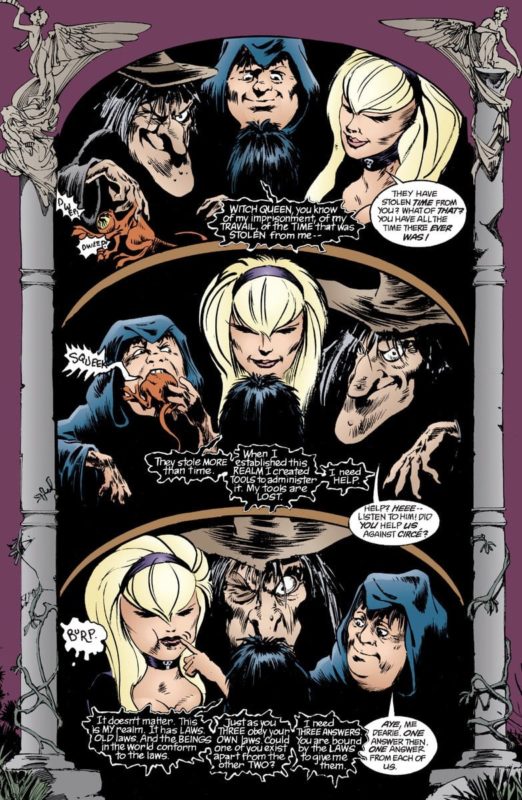
Despite some obvious name dropping the story is very strong in Issue #2. I like the fates, they’re mysterious and sassy, everything a trio of supernatural women should be! The time spent in Dreamtime is a little unfocused feeling but it’s Dreamtime, that makes sense. The clear outline for the rest of Morpheus’s adventure is nice, almost like a chapter list at the beginning of a book and I liked knowing where the plot was headed.
The Sandman #3
In The Sandman #3, Morpheus meets up with John Constantine to recover his pouch. However, it turns out that Constantine no longer has the pouch. It was stolen from him long ago by an ex-girlfriend. Upon hearing this Morpheus goes to leave but Constantine insists on coming with him to help. It turns out that Morpheus’s pouch wasn’t empty, it was filled with magic sleep sand. Constantine’s ex has become addicted to the sands and spends all her time in a sand-induced sleep. Her dreams have become real and overrun the house she stays in, trying to ensnare anyone who ventures within.
Gaiman’s story shows the folly of being too obsessed with dreams and forgetting to live. In the end, Morpheus is able to make the dreams infesting the house retreat but he cannot save the girl. I saw this as an allegory for how dreams will eventually fade if you don’t do anything to make them come true. Then you will be left broken and alone, with nothing to show for your life.
The Sandman #4
After retrieving his pouch full of sands, Morpheus decides to head to hell to retrieve his helm. Here we run into another favorite character, Lucifer, Lord of Hell. Morpheus meets with Lucifer only to find that he is no longer the only power in Hell. Hell is now run by a triumvirate.
Once Lucifer is joined by his partners Azazel and Beelzebub they agree to help Morpheus. But when they find the demon with the helm he refuses to give it up. Morpheus challenges him and so begins a battle that visually was silly but was intellectually very satisfying.
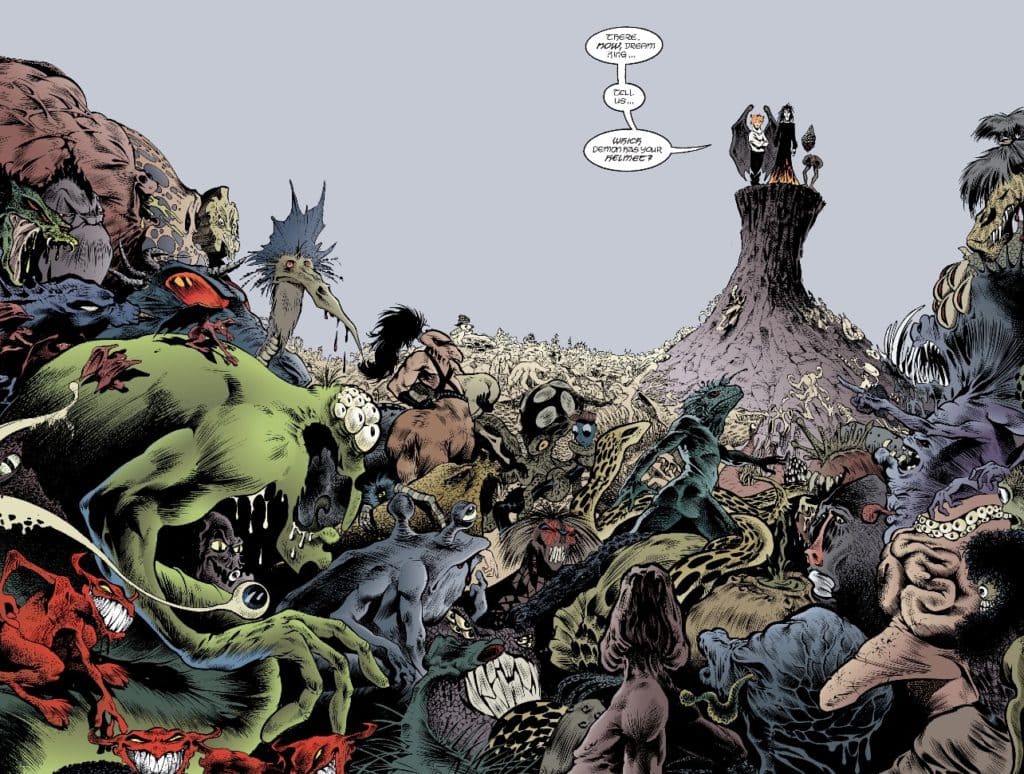
When the battle begins the panels look like, I kid you not, a nightclub and I thought for a crazy second “Oh god, it’s going to be a rap battle, how stupid!” Then the battle began and I realized it was a wizard’s battle! I went from unenthused to ecstatic in a snap.
Battles of wit are always interesting to see and this one didn’t disappoint. The visuals remained a little jarring but the exchanges were amazing. In the end, Morpheus of course wins and regains his helm, ready to continue his quest.
Morpheus’s time in hell is meant to show the hope that is embedded in dreams. Without that hope we cannot grow and become more, we are just stuck exactly where we are forever. If issue #3 showed us the danger of being lost in dreams then issue #4 showed us the importance of dreams. It was a wonderful reminder to never stop believing!
The Sandman #5
In The Sandman #5, Morpheus tracks down his ruby but finds that it is somehow changed. It psychically attacks him and he collapses. Meanwhile, Dr. Dee (Dr. Destiny’s new name) has escaped and comes for the ruby as well. Turns out he is the one who altered it so it now only works for him.
This issue was another very fast read, similar to issue #2. The main purpose seems to have been making a few name drops at the JLA and adding extra obstacles to Morpheus’s journey. It had a little bit of a feeling of filler to it, although if you skipped it you would be lost in later issues so it wasn’t really filler. I guess it was just a little low-key and not my favorite issue.
The Sandman #6
In issue #6 we see Dr. Dee trap six people in a diner and use the power of the ruby to twist them to his will for the next 24 hours. He starts off small but as time goes by he becomes more and more depraved and the things he makes them do become more and more sickening.
In the end, they all die. The whole world is suffering similarly, as told to us by a TV in the diner, but it is these six people that we really get to see and feel for.
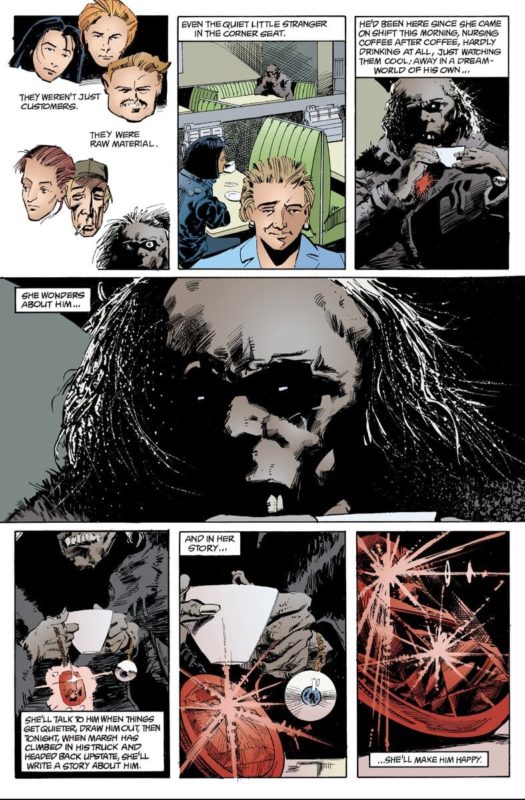
Issue #6 is really a parable for when others control our dreams. The ruby gives Dr. Dee the ability to see and control the dreams of others and he uses it to make them do horrible things that they never would do otherwise. Similarly, if we allow others to tell us what our dreams are we will end up unhappy in the end (hopefully not as unhappy as those six but still).
I really like how Gaiman uses each of Morpheus’s tools to teach us something about dreams. The lessons are subtle but they are still being absorbed one way or the other as they’re read. It gives the story a depth far beyond just punching a bad guy and I love it.
The Sandman #7
Time to save the world! Morpheus never set out to save the world, that’s not what this story is about. But in order to fulfill his own quest of recovering his stolen property, he’ll have to regain his ruby from Dr. Dee and by default save the world. The battle between these two takes place in the land of Dreamtime, using dreams as their weapons.
Because the ruby has been so altered by Dr. Dee, Morpheus cannot simply take it from him and the ruby has managed to steal more and more power from him. It looks like Morpheus might lose the fight when Dr. Dee wrongly comes to the conclusion that destroying the ruby, which contains so much of Morpheus’s power, will destroy Morpheus.
Instead, Morpheus regains all the power the gem has taken from him. He is stronger than he’s been in eons and Dr. Dee is left powerless. Morpheus returns Dr. Dee to Arkham and sends the world to peaceful sleep. When everyone awakens everything will have been like a very bad dream and life will return to normal.
The moral behind issue #7 is: set your dreams free and you can do anything. At the beginning of the fight, Dr. Dee has control over dreams with his ruby so he has all the power in the battle. As soon as the ruby is destroyed and the dreams are set free, Morpheus is in control again and the battle is over, just like that. I absolutely loved that.
The stories within the stories of The Sandman are so inspirational and uplifting that I think everyone should read them. It feels like something the world needs right now.
The Sandman #8
Time for the wrap-up. Morpheus has finished his quest and is left feeling unsure of what to do next. It’s something I’ve often wondered myself after reading a story, now that the hero has obtained whatever they’ve been trying so hard to achieve, what comes next?
As Morpheus struggle with this question, he meets up with his sister Death. She takes him along on her rounds and as he watches her deal compassionately with each soul he begins to feel his own purpose again. After a time he is ready to return to his kingdom and his duties as Dream. It was a neat way for Gaiman to tie his story up with a bow and give it away to all of us.
Bringing The Sandman to life through art
Sam Keith and Mike Dringenberg bring the world of The Sandman to life through beautiful artwork. The covers are very ethereal. The edges are muted and blurred to invoke the world of dreams. Inside the pictures are more in focus.
The style is much more realistic and the colors are dark. Undoubtedly darker colors were chosen to convey feelings of nighttime and sleep to the reader.
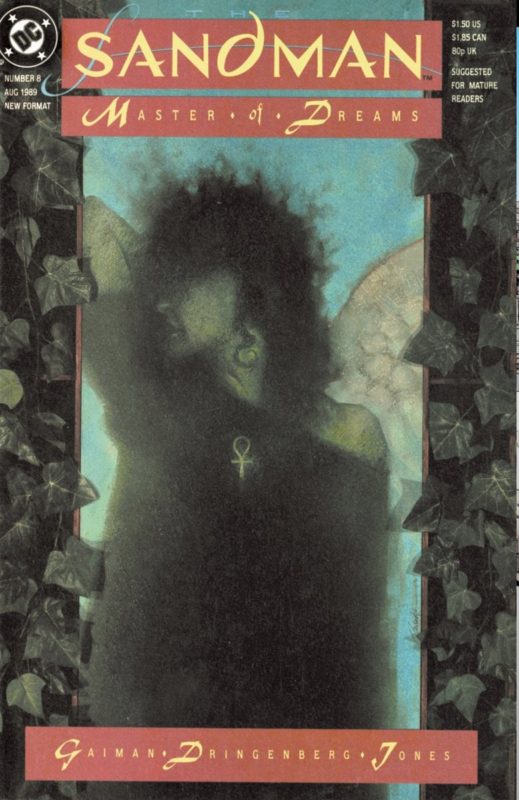
Issue #8 is very different from the rest of the series. The cover is still amazing (possibly my favorite) and in the same style as the other seven but the inside is markedly different. Issue #8 contains lots of bright colors.
Even though the story is mostly concerned with death, the colors are the lightest seen in the series. I think this is because a point is being made that death is not a scary thing to be avoided but a necessary and, dare I say, beautiful part of life.
I also think the colors are so different because Morpheus entered the peace at the end of his quest. His imprisonment and the frantic search for his missing tools are behind him and he can relax and see the beauty of the world and his place in it now.
Ending the visit
This entire series was amazing. I really loved all the meaning hidden deep within the panels. Honestly, I want to see the English course devoted to the meaning behind The Sandman, it could be eye-opening for those that see comics as only for kids.
Gaiman weaves a tale that is entertaining and illuminating all at once. The art that accompanies the story enhances the overall story and adds layers to the meanings within. I am eagerly awaiting the Netflix series that inspired me to read The Sandman. If it is half as good as the source material, it should be spectacular!
Rating: 9.5/10
The Sandman by Neil Gaiman, Sam Keith, and Mike Dringenberg is available via most comics and booksellers including DC Universe Infinite.
Have you read The Sandman? What did you think? Let us know over on Twitter or Facebook! If you haven’t already, check out my comic reviews for The Umbrella Academy!



